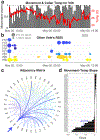A Wireless Wearable Ecosystem for Social Network Analysis in Free-living Animals
- PMID: 38948074
- PMCID: PMC11210449
- DOI: 10.1109/lsens.2024.3406328
A Wireless Wearable Ecosystem for Social Network Analysis in Free-living Animals
Abstract
Studying animal social systems requires understanding variations in contact and interaction, influenced by factors like environmental conditions, resource availability, and predation risk. Traditional observational methods have limitations, but advancements in sensor technologies and data analytics provide new opportunities. We developed a wireless wearable sensor system, "Juxta," with features such as modular battery packs and a smartphone app for data collection. A pilot study on free-living prairie voles (Microtus ochrogaster), a species with complex social behavior, demonstrated Juxta's potential for studying social networks and behavior. We propose a framework for merging temporal, spatial, and event-driven data, which can help explore complex social dynamics across species and environments.
Keywords: Wireless sensors; behavioral tracking; contact tracing; neuroethology; social networks.
Figures



References
-
- Tentelier C, Aymes J-C, Spitz B, and Rives J, “Using proximity loggers to describe the sexual network of a freshwater fish,” Environ. Biol. Fishes, 99, no. 8, pp. 621–631, Sep. 2016, doi: 10.1007/s10641-016-0504-y. - DOI
-
- Mennill DJ, Doucet SM, Ward K-AA, Maynard DF, Otis B, and Burt JM, “A novel digital telemetry system for tracking wild animals: a field test for studying mate choice in a lekking tropical bird,” Methods Ecol. Evol, 3, no. 4, pp. 663–672, 2012, doi: 10.1111/j.2041-210X.2012.00206.x. - DOI
-
- Kirkpatrick L et al. , “ProxLogs: Miniaturised proximity loggers for monitoring association behaviour in small mammals,” Animal Behavior and Cognition, preprint, Mar. 2021. doi: 10.1101/2021.02.28.432842. - DOI
Grants and funding
LinkOut - more resources
Full Text Sources
